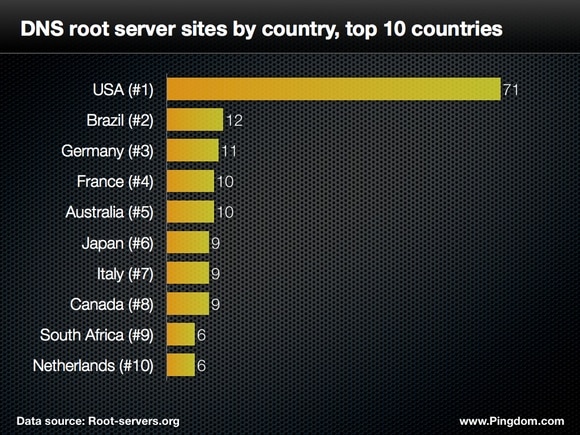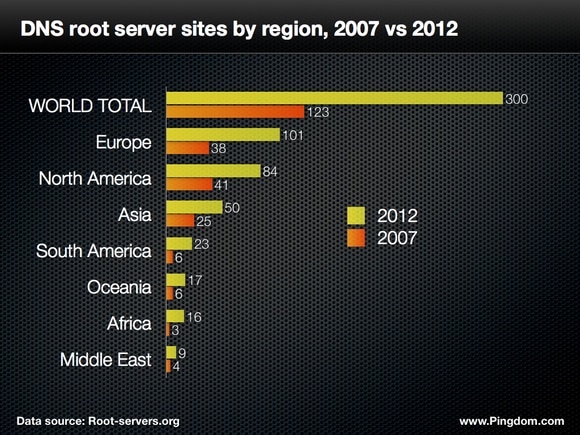
As we noted a couple of weeks ago, the number of Internet users has doubled in the past five years. To handle this enormous influx of users, Internet’s infrastructure needs to grow as well. The Domain Name System (DNS), a critical part of that infrastructure, has more than met the challenge.
Five years ago there were 123 DNS root server sites (the “backend” of DNS) spread out on the Internet. Today there are more than twice as many, over 300. Five years ago, 46 countries had root servers. Today, 76 have them.
In other words, not only has the number of root servers grown tremendously, but their geographical spread has increased as well. This is good news for the overall stability and performance of DNS worldwide.
An interesting side note is that Europe has overtaken North America as the world region with the most root server sites.
Top 10 countries
The US hold over Internet’s infrastructure has been slipping for a while, and that trend isn’t changing. In 2007, the United States hosted 29.3% of all root server sites. Today, that number has gone down to 23.7%.
That said, if you look at single countries, the United States is still in a class of its own. Here are the top 10 countries and the number of root server sites in each:

Higher-res png version available here.
All 76 countries
For the sake of completeness, here is the full list of all 76 countries with root server sites:
71 root server sites: USA 12 root server sites: Brazil 11 root server sites: Germany 10 root server sites: France Australia 9 root server sites: Japan Italy Canada 6 root server sites: South Africa Netherlands 5 root server sites: Hong Kong Sweden UK New Zealand 4 root server sites: Egypt China India Singapore South Korea Belgium Norway Poland Russia Spain Switzerland 3 root server sites: Kenya Indonesia Malaysia Philippines Taiwan Czech Rep. Finland Turkey Saudi Arabia Argentina Chile 2 root server sites: Bangladesh Austria Bulgaria Greece Ireland Luxembourg Portugal Ukraine Qatar UAE 1 root server site: Mozambique Senegal Tanzania Armenia Bhutan Nepal Pakistan Sri Lanka Thailand Denmark Estonia Hungary Iceland Latvia Lithuania Montenegro Romania Bahrain Israel Mexico Sint Maarten Panama Puerto Rico Fiji Guam Colombia Ecuador Peru Uruguay Venezuela
An additional five years from now there may very well be over a 100 countries on this list.
Growth by world region
The geographical distribution of the DNS infrastructure is vital. The closer you are to a root server, the faster your DNS lookups can be handled.
In addition to performance considerations, having a large number of root server sites ensures stability if there are local network disruptions or even direct attacks on the DNS infrastructure. Disruptions are more common on the Internet than most people are aware of. We notice it simply because our service monitors the uptime of hundreds of thousands of websites around the world.
The number of root server sites has increased in every part of the world, although Europe and North America have laid claim to the bulk of them.

Higher-res png version available here.
Needless to say, the division isn’t quite as equal as it probably should be, but we’ll have a closer look at that next week.
The hardware boost factor
There is another aspect to the increasing capacity of Internet’s DNS infrastructure that we haven’t taken into consideration here, which is that server hardware is getting more powerful, and can handle more requests.
So really, you not only have more root server sites, but on average they are bound to be more powerful as time goes by. Thus the total capacity increase is larger than the increase in locations.
Final words
Without a well-functioning DNS, the Internet would be pretty useless to most of us. Who would want to use IP addresses instead of domain and host names? It’s one of those technologies that we use all the time without really thinking about it.
Since the DNS root servers are so critical to the Internet, we’re very happy to see that they are keeping pace with the general growth of the Internet. A more robust network of root servers is also much harder to damage or overload, either by accident or on purpose.
We’re actually not done with this data yet. We have one more post coming with additional analysis in a couple of days, so stay tuned (it’s out!).
Data source: Root-servers.org and our own modest fiddling with those numbers.
Top image via Shutterstock.
























